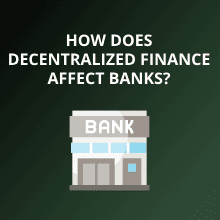Decentralized finance (DeFi) has initiated a shift in how traditional financial systems work, and the growth of digital currencies across the world is partly a by-product of DeFi’s influence on the global financial system.
The value proposition of this innovation is unique, and it promises an era where people can control a system more than centralized authorities can.
The concept of DeFi is exciting, especially because of the way it could change traditional banking.
We take a look at how this could happen and what DeFi is all about.

The Basics of Decentralized Finance
Imagine a system where you pay lower transaction fees and can send and receive funds without going through a third party.
With DeFi, you don’t have to imagine.
The concept of decentralized finance is the exact opposite of traditional finance (TradFi).
Instead of going through your bank or third parties, DeFi allows users to carry out transactions through peer-to-peer networks and a personalized wallet that facilitates storage.
DeFi is becoming more mainstream, with over $11.96 billion trading volume on decentralized crypto exchanges in 2021 and a market forecast of $232.2 billion by 2030.
It might have started with the notion of being another infamous Ponzi scheme, but the realities are quite different now.
Millions of people trade crypto and use crypto exchanges on a daily basis.
The 24-hour trading volume on decentralized exchanges today is $4.13 billion, and the 24-hour trading volume on the crypto market is $95 billion.
For the first time in centuries, we’re witnessing how a global financial system can develop at a large scale without third parties.
The only downside is that DeFi applications cannot measure up to TradFi when it comes to security.

DeFi vs TradFi: Industry Response to Decentralized Banking
The future realities of smart contracts and decentralized finance are still up for debate.
Many argue that it would be more of an opportunity for banks than an existential threat to the way they operate.
One of the opportunities is for banks to look into using smart contracts to automate their transactions or utilize blockchain technology to facilitate transactions.
The convenience of an online banking platform that can perform transactions in split seconds would be exciting for everyone, and it would be more beneficial for banks to exploit this rather than see it as a threat.
A New Era for Digitized Banking
The spiraling plans for Central Bank Digital Currencies (CBDCs) are one of the responses we should expect in the global financial system moving forward.
It indicates that DeFi is propelling the world into a more digitized era of financing.
Countries and central banks are now considering the scenario where users can utilize digital assets in making transactions and buying and selling goods and services.
DeFi and TradFi can co-exist and do not have to operate dependently.
Just like there are regulatory attempts and reforms for the crypto community,
TradFi could also attempt to catch up with the fast-paced digitized era DeFi has ushered in.

Change in Investment Dynamics
The crypto network has a global market cap of $1.43 trillion as of November 16, 2022, but reached close to $3 trillion, an all-time high, in November 2021.
For a technology only over a decade old, this is seen as unparalleled growth.
Investment opportunities in crypto and DeFi have gone through the roof, and the interest so far is almost unbeatable compared to TradFi.
There are opportunities with Initial Coin Offerings (ICOs), DeFi lending and staking, yield farming, and staking.
This year, we witnessed projects like Pepe Coin produce a 1,170% increase for investors in the first two weeks of launch.
The possibility of investment opportunities in TradFi offering such high interest, especially in such a short timeframe, is almost unheard of.
Investment dynamics in the decentralized finance system have raised the bar, and TradFi might have to find ways to measure up.
DeFi: An Opportunity or A Threat?
According to the World Bank, about 1.7 billion adults have limited access to banking services.
The basis of a system like DeFi is to provide easy financial services to anyone, anywhere in the world, including individuals without proper access.
Traditional banking systems would benefit more from emulating this, taking pointers, or exploring DeFi technology.
That way, they can secure a seat in the future of digitized banking.
However, the DeFi system is still in its infancy.
Contrary to popular claims, it is unlikely to overtake the traditional banking system anytime soon.
There are security issues, hacks, thefts, threats, and scalability to combat before we begin to see it to its fullest potential.



